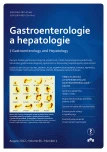Constipation and surviving myths. Laxatives
Authors:
J. Martínek
Authors‘ workplace:
Interní klinika 1. LF UK a ÚVN Praha
Published in:
Gastroent Hepatol 2012; 66(4): 249-255
Category:
Clinical and Experimental Gastroenterology: Review Article
Overview
Constipation is a set of symptoms which affects up to 20% of the population. If caused by a specific disease, we speak about secondary constipation. Secondary constipation is treated based on its actual cause. Primary constipation is caused either by insufficient large bowel motility (so-called colon inertia syndrome or inert colon) or by problematic evacuation due to defecation reflex disturbances (= anismus) or anatomical changes in the rectum region (= obstructive defecation syndrome, ODS). Anismus and ODS represent “terminal” constipation. A patient with longer-lasting constipation should undergo a thorough examination by a gastroenterologist. Terminal constipation can successfully be resolved by physiotherapy or surgery. On the contrary, colon inertia syndrome can often only be resolved by the long-term administration of laxatives. We distinguish bulk-forming, stimulant, osmotic and other laxatives. Laxatives are used not only in patients with constipation but also for bowel “cleansing“ before surgical and diagnostic interventions in the large bowel. Many myths exist with respect to laxatives, which are traditionally “copied” from one textbook to another and are rooted in the thinking of both doctors and the general public. Such myths say, for instance, that stimulant laxatives cause harm, are addictive and worsen the already present constipation. None of that has ever been scientifically proven. Stimulant laxatives are fully efficient and safe even if used for a period over 15 years. Recently, a number of studies have been published which prove both the efficacy and safety of stimulant laxatives. Unequivocal data on their absolute safety in long-term use are lacking, however, no information exists on their harmfulness if taken over a long time. Therefore, discouraging a patient from taking laxatives if they are efficient can currently be considered the wrong attitude. The following article summarises, in particular, current laxative-related issues.
Key words:
constipation – colon inertia – anismus – ODS – laxatives
The author declares he has no potential conflicts of interest concerning drugs, products, or services used in the study.
The Editorial Board declares that the manuscript met the ICMJE „uniform requirements“ for biomedical papers.
Submitted:
1. 7. 2012
Accepted:
27. 7. 2012
Sources
1. Longstreth GF, Thompson WG, Chey WD et al. Functional bowel disorders. Gastroenterology 2006; 130(5): 1480–1491.
2. Mařatka Z et al. Praktická gastroenterologie. Praha: St Zdrav Nakl 1964.
3. Mařatka Z. Klinická gastroenterologie. Praha: Avicenum 1988.
4. Feldman M, Friedman LS, Brandt LJ et al. Sleisenger and Fordtran’s Gastrointestinal and Liver Disease. 8th ed. Philadelphia: Saunders-Elsevier 2006.
5. Müller-Lissner SA, Kamm MA, Scarpignato C et al. Myths and misconceptions about chronic constipation. Am J Gastroenterol 2005; 100(1): 232–242.
6. Redmond JM, Smith GW, Barofsky I et al. Physiological tests to predict long-term outcome of total abdominal colectomy for intractable constipation. Am J Gastroenterol 1995; 90(5): 748–753.
7. Baker JT, Harvey RF. Bowel habit in thyrotoxicosis and hypothyroidism. Br Med J 1971; 1(5744): 322–323.
8. Parisi GC, Zilli M, Miani MP et al. High-fiber diet supplementation in patients with irritable bowel syndrome (IBS): a multicenter, randomized, open trial comparison between wheat bran diet and partially hydrolyzed guar gum (PHGG). Dig Dis Sci 2002; 47(8): 1697–1704.
9. Tzavella K, Schenkirsch G, Riepl RL et al. Effects of long-term treatment with anthranoids and sodium picosulphate on the contents of vasoactive intestinal polypeptide, somatostatin and substance P in the rat colon. Eur J Gastroenterol Hepatol 1995; 7(1): 13–20.
10. Ghadially FN, Walley VM. Melanoses of the gastrointestinal tract. Histopathology 1994; 25(3): 197–207.
11. Geboes K. Laxatives and intestinal epithelial cells: a morphological study of epithelial cell damage and proliferation. Verh K Acad Geneeskd Belg 1995; 57(1): 51–74.
12. Bengtsson M, Ohlsson B. Retrospective study of long-term treatment with sodium picosulfate. Eur J Gastroenterol Hepatol 2004; 16(4): 433–434.
13. Ryan F, Anobile T, Scutt D et al. Effects of oral sodium picosulphate Picolax on urea and electrolytes. Nurs Stand 2005; 19(45): 41–45.
14. Kamm MA, Mueller-Lissner S, Wald A et al. Oral bisacodyl is effective and well tolerated in patients with chronic constipation. Clin Gastroenterol Hepatol 2011; 9(7): 577–583.
15. Mueller-Lissner S, Kamm MA, Wald A et al. Multicenter, 4-week, double-blind, randomized, placebo controlled trial of sodium picosulfate in patients with chronic constipation. Am J Gastroenterol 2010; 105(4): 897–903.
16. Kordač V et al. Vnitřní lékařství II. Praha: Avicenum 1988.
17. Češka R et al. Interna. Praha/Kroměříž: Triton 2010.
Labels
Paediatric gastroenterology Gastroenterology and hepatology SurgeryArticle was published in
Gastroenterology and Hepatology

2012 Issue 4
Most read in this issue
- Defecography
- Constipation and hypofunction of the thyroid glandMyth or reality?
- Solitary rectal ulcer syndrome
- Treatment of spontaneous bacterial peritonitis
